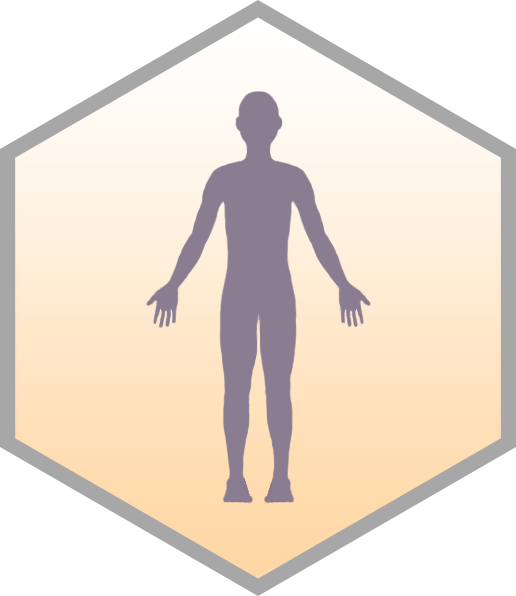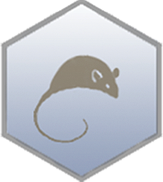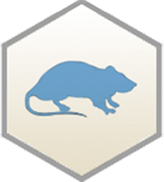GRR1 / YJR090C Overview
- Standard Name
- GRR1 1
- Systematic Name
- YJR090C
- SGD ID
- SGD:S000003850
- Aliases
- CAT80 16 , COT2 6 , SSU2 9 , SDC1 17 , RMR3 18
- Feature Type
- ORF , Verified
- Description
- F-box protein component of an SCF ubiquitin-ligase complex; modular substrate specificity factor which associates with core SCF (Cdc53p, Skp1p and Hrt1p/Rbx1p) to form the SCF(Grr1) complex; SCF(Grr1) acts as a ubiquitin-protein ligase directing ubiquitination of substrates such as: Gic2p, Mks1p, Mth1p, Cln1p, Cln2p and Cln3p; involved in carbon catabolite repression, glucose-dependent divalent cation transport, glucose transport, morphogenesis, and sulfite detoxification 2 3 4 5 6 7 8 9 10 11 12 13 14 15
- Name Description
- Glucose Repression-Resistant 1
- Comparative Info
-






Sequence
The S. cerevisiae Reference Genome sequence is derived from laboratory strain S288C. Download DNA or protein sequence, view genomic context and coordinates. Click "Sequence Details" to view all sequence information for this locus, including that for other strains.
- Summary
- GRR1/YJR090C is located on the right arm of chromosome X between BIR1 and JSN1; coding sequence is 3456 nucleotides long with a variable AAC trinucleotide repeat and 34 SNPs, 13 of which cause amino acid polymorphisms
Analyze Sequence
S288C only
BLASTN | BLASTP | Design Primers | Restriction Fragment Map | Restriction Fragment Sizes | Six-Frame Translation
S288C vs. other species
BLASTN vs. fungi | BLASTP at NCBI | BLASTP vs. fungi
S288C vs. other strains
Protein
Basic sequence-derived (length, molecular weight, isoelectric point) and experimentally-determined (median abundance, median absolute deviation) protein information. Click "Protein Details" for further information about the protein such as half-life, abundance, domains, domains shared with other proteins, protein sequence retrieval for various strains, physico-chemical properties, protein modification sites, and external identifiers for the protein.
- Summary
- Grr1p is 1151 amino acids long, extremely low in abundance; contains disordered regions at both termini, an F-box domain, 11 cysteine-containing leucine-rich repeats, and a variable stretch of Asn residues; ubiquitinylated on K567 and K622; phosphorylated on 10 residues
- Length (a.a.)
- 1151
- Mol. Weight (Da)
- 132722.7
- Isoelectric Point
- 6.48
- Median Abundance (molecules/cell)
- 780 +/- 664
Alleles
Curated mutant alleles for the specified gene, listed alphabetically. Click on the allele name to open the allele page. Click "SGD search" to view all alleles in search results.
View all GRR1 alleles in SGD search
Gene Ontology
GO Annotations consist of four mandatory components: a gene product, a term from one of the three Gene Ontology (GO) controlled vocabularies (Molecular Function, Biological Process, and Cellular Component), a reference, and an evidence code. SGD has manually curated and high-throughput GO Annotations, both derived from the literature, as well as computational, or predicted, annotations. Click "Gene Ontology Details" to view all GO information and evidence for this locus as well as biological processes it shares with other genes.
- Summary
- Subunit of SCF ubiquitin ligase complex; involved in SCF-dependent proteasomal ubiquitin-dependent protein catabolism, pheromone-responsive mitotic cell cycle G1 arrest, and cellular responses to DNA damage stimulus and methylmercury; localizes to nucleus, cytoplasm, and bud neck contractile ring
View computational annotations
Molecular Function
- Manually Curated
- enables protein-macromolecule adaptor activity (IDA, IMP)
- enables ubiquitin-protein transferase activity (IDA)
Biological Process
- Manually Curated
- involved in cellular response to methylmercury (IMP)
- involved in cellular response to oxidative stress (IMP)
- involved in mitotic cell cycle G1 arrest in response to pheromone (IMP)
- involved in protein polyubiquitination (IMP, IGI)
- involved in SCF-dependent proteasomal ubiquitin-dependent protein catabolic process (IMP, IPI)
Cellular Component
- Manually Curated
- located in cellular bud neck contractile ring (IDA)
- located in cytoplasm (IDA)
- located in nucleus (IDA)
- part of SCF ubiquitin ligase complex (IMP)
Complex
Macromolecular complex annotations are imported from the Complex Portal. These annotations have been derived from physical molecular interaction evidence extracted from the literature and cross-referenced in the entry, or by curator inference from information on homologs in closely related species or by inference from scientific background.
Phenotype
Phenotype annotations for a gene are curated single mutant phenotypes that require an observable (e.g., "cell shape"), a qualifier (e.g., "abnormal"), a mutant type (e.g., null), strain background, and a reference. In addition, annotations are classified as classical genetics or high-throughput (e.g., large scale survey, systematic mutation set). Whenever possible, allele information and additional details are provided. Click "Phenotype Details" to view all phenotype annotations and evidence for this locus as well as phenotypes it shares with other genes.
- Summary
- GRR1/YJR090C is a non-essential gene; null mutants are viable, slow-growing, and associated with a range of mutant phenotypes that significantly impact cellular functions and overall fitness. Mutants lacking GRR1 exhibit decreased resistance to both acidic and alkaline pH levels, which may hinder their survival in varying environmental conditions. These mutants show an increased ability to form biofilms, which could affect their interactions with surfaces and other cells. The budding pattern in null mutants is abnormal, characterized by bipolar budding, and bud morphology is also disrupted, indicating potential issues with cell division. Competitive fitness is diminished, leading to reduced viability in resource-limited environments, while desiccation resistance is decreased, making them more vulnerable to dry conditions. The rate of fermentative growth is reduced, and these mutants also exhibit decreased resistance to freeze-thaw cycles. Invasive growth is increased, suggesting an enhanced ability to penetrate surfaces or tissues. Resistance to killer toxins is decreased, and lipid particle morphology is abnormal, which may impact cellular metabolism. Furthermore, oxidative stress resistance is diminished, and respiratory growth is absent, indicating a reliance on fermentation for energy production. UV resistance is also decreased, further underscoring their vulnerability to environmental stressors. Reduced function mutants show an increased rate of fermentative metabolism, suggesting a compensatory mechanism in response to the loss of function. However, when GRR1 is overexpressed, competitive fitness is again decreased, and UV resistance is diminished, indicating that excessive levels of the gene or gene product may also be detrimental.
Classical Genetics
- null
- alkaline pH resistance: decreased
- bipolar budding pattern: abnormal
- chemical compound accumulation: decreased
- chemical compound accumulation: increased
- invasive growth: increased
- oxidative stress resistance: decreased
- protein/peptide accumulation: increased
- protein/peptide modification: increased
- resistance to chemicals: decreased
- resistance to chemicals: increased
- RNA accumulation: increased
- utilization of carbon source: absent
- overexpression
- reduction of function
- null
- acid pH resistance: decreased
- biofilm formation: increased
- bud morphology: abnormal
- chemical compound accumulation: abnormal
- chemical compound accumulation: decreased
- chemical compound accumulation: increased
- competitive fitness: decreased
- desiccation resistance: decreased
- fermentative growth: decreased rate
- freeze-thaw resistance: decreased
- heat sensitivity: decreased
- heat sensitivity: increased
- killer toxin resistance: decreased
- lipid particle morphology: abnormal
- metal resistance: decreased
- oxidative stress resistance: decreased
- resistance to chemicals: decreased
- respiratory growth: absent
- toxin resistance: decreased
- utilization of carbon source: decreased rate
- utilization of carbon source: increased
- utilization of nitrogen source: decreased rate
- UV resistance: decreased
- vegetative growth: decreased rate
- viable
- overexpression
Large-scale Survey
Interaction
Interaction annotations are curated by BioGRID and include physical or genetic interactions observed between at least two genes. An interaction annotation is composed of the interaction type, name of the interactor, assay type (e.g., Two-Hybrid), annotation type (e.g., manual or high-throughput), and a reference, as well as other experimental details. Click "Interaction Details" to view all interaction annotations and evidence for this locus, including an interaction visualization.
- Summary
- Grr1p interacts physically with proteins involved in mitotic cell cycle; GRR1 interacts genetically with genes involved in mitotic cell cycle
218 total interactions for 112 unique genes
Physical Interactions
- Affinity Capture-MS: 35
- Affinity Capture-RNA: 8
- Affinity Capture-Western: 51
- Biochemical Activity: 3
- Co-localization: 1
- Co-purification: 1
- FRET: 1
- PCA: 2
- Reconstituted Complex: 14
- Two-hybrid: 24
Genetic Interactions
- Dosage Lethality: 7
- Dosage Rescue: 13
- Negative Genetic: 4
- Phenotypic Enhancement: 2
- Phenotypic Suppression: 6
- Positive Genetic: 1
- Synthetic Growth Defect: 16
- Synthetic Lethality: 14
- Synthetic Rescue: 15
Regulation
The number of putative Regulators (genes that regulate it) and Targets (genes it regulates) for the given locus, based on experimental evidence. This evidence includes data generated through high-throughput techniques. Click "Regulation Details" to view all regulation annotations, shared GO enrichment among regulation Targets, and a regulator/target diagram for the locus.
Expression
Expression data are derived from records contained in the Gene Expression Omnibus (GEO), and are first log2 transformed and normalized. Referenced datasets may contain one or more condition(s), and as a result there may be a greater number of conditions than datasets represented in a single clickable histogram bar. The histogram division at 0.0 separates the down-regulated (green) conditions and datasets from those that are up-regulated (red). Click "Expression Details" to view all expression annotations and details for this locus, including a visualization of genes that share a similar expression pattern.
Summary Paragraph
A summary of the locus, written by SGD Biocurators following a thorough review of the literature. Links to gene names and curated GO terms are included within the Summary Paragraphs.
Last Updated: 2025-04-07
Literature
All manually curated literature for the specified gene, organized into topics according to their relevance to the gene (Primary Literature, Additional Literature, or Review). Click "Literature Details" to view all literature information for this locus, including shared literature between genes.